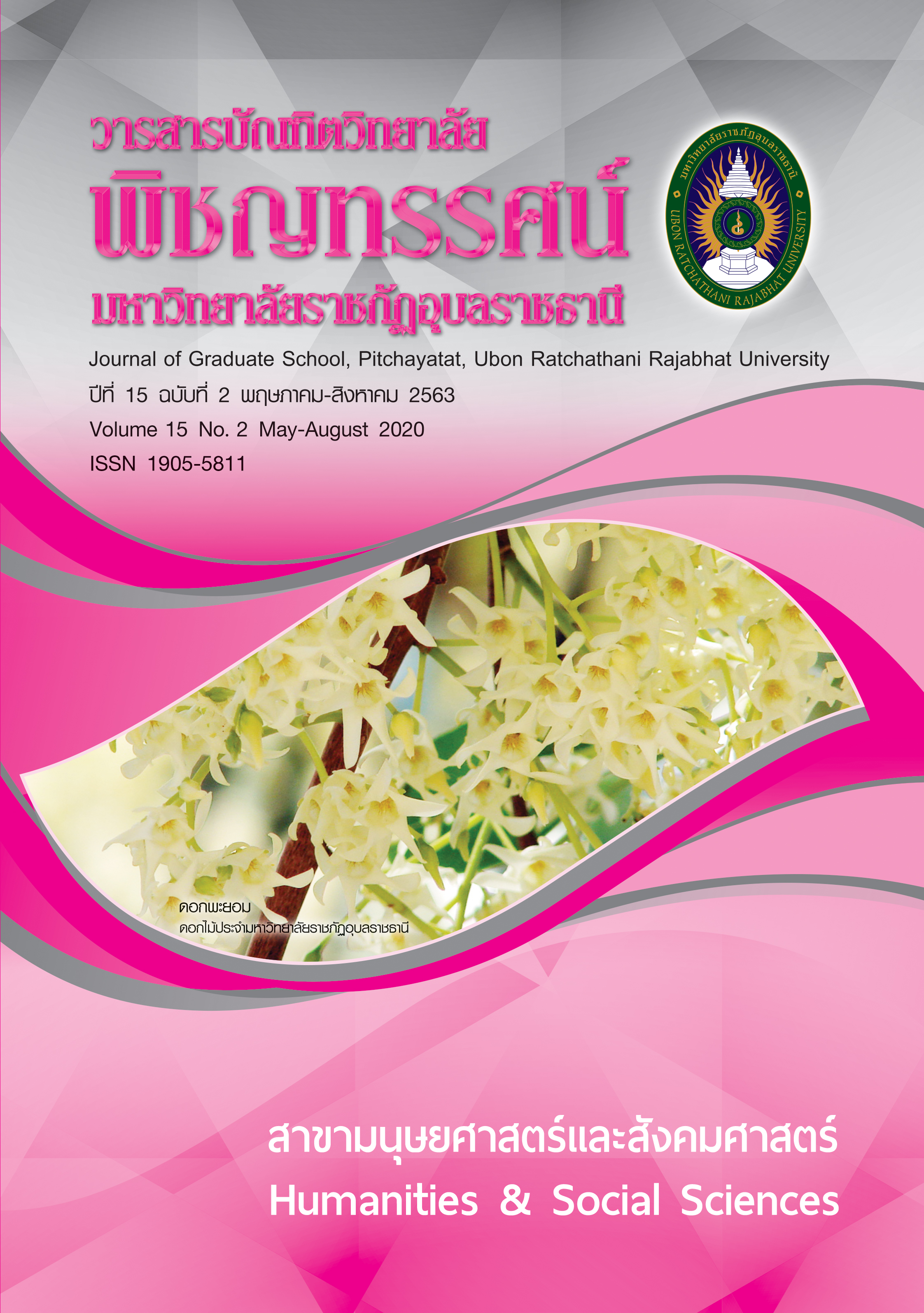A Mixed Method Research of Factors Affecting Faculty Retention in Four-Year Public Higher Education Institutions in Guangxi Zhuang Autonomous Region People’s Republic of China
บทคัดย่อ
The purpose of this research was to identify factors affecting faculty retention in four-year public higher education institutions in Guangxi China. The samples of this research were 460 randomly sampling full-time teachers. There were 4 latent variables: job satisfaction (JS), organizational commitment (OC), job embeddedness (JE), and faculty retention (FR), which were measured by 20 observed variables. The research instruments for the quantitative phase were questionnaires, which had the reliability coefficients from 0.90 to 0.94. Data were analyzed to obtain mean, standard deviation, skewness, and kurtosis. Structural equation modeling was employed to examine the relationships of variables and test the consistency of hypothesis model with empirical data.
This research found that the hypothesis model of factors affecting faculty retention in higher education institutions in Guangxi China were confirmed to be in consistent with the empirical data, with (164) = 172.639, p=.30, CFI = .997, RMSEA = .011, SRMR = .029. The variables in the model could describe the factors affecting faculty retention in higher educational institutions in Guangxi China variance at 54.6 percent (R2=.546). There were three variables that had direct positive effect on faculty retention in higher education institutions in Guangxi China: job embeddedness, job satisfaction, and organizational commitment with influence coefficient of .345, .344, and .274 respectively at the significant level of .01. There were two variables that had indirect positive effect on faculty retention in higher education institutions in Guangxi China: job embeddedness and job satisfaction with influence coefficient of .222 and .089 respectively at the significant level of .01. The total effect consisted of three variables, job embeddedness, job satisfaction, organizational commitment, with influence coefficient of .576, .433, and .274 respectively at the significant level of .01.
Keywords: Job Embeddedness, Organizational Commitment, Job Satisfaction, Faculty Retention, Higher Education Institutions in Guangxi China
เอกสารอ้างอิง
Collins, J. Good to Great and the Social Sector. New York: Harper Collins, 2005.
Crossley, C. D. et al. “Development of a Global Measure of Job Embeddedness and Integration into a Traditional Model of Voluntary Turnover,” Journal of Applied Psychology. 92, 4 (2007):1031-1042.
Gelfand, M. J., Raver, J. L., and Ehrhart, K. H. Methodological Issues in Cross-cultural Organizational Research. In Rogelberg, S. G. Editor. Handbook of Research Methods in Industrial and Organizational Psychology. MA: Blackwell Publishers, 2002.
Griffeth, R. W., Hom, P. W., and Gaertner, S. A “meta-analysis of antecedents and correlates of employee turnover: Update, moderator tests, and research implications for the millennium,” Journal of Management. 26, 3 (2000): 463-488.
Harrison, H. D. and Hargrove, M. J. “Ageing faculty: Workforce challenges and issues facing higher education,” Business Perspectives. 18, 2 (2006): 20-25.
Hom, P. W., and Griffeth, R. W. Employee turnover. Cincinnati: Southwestern Publishing Company, 1995.
Hom, P. W., et al. “Explaining employment relationships with social exchange and job embeddedness,” Journal of Applied Psychology. 94, 2 (2009): 277- 297.
Hu, L. and Bentler, P. M. “Cutoff Criteria for Fit Indexes in Covariance Structure Analysis: Conventional Criteria Versus New Alternatives,” Structural Equation Modeling. 6, 1 (1999): 1-55.
Kline, R. B. Principles and practices of structural equation modeling. 5th Ed. New York: The Guilford Press, 2011.
Lee, T. W., and Mitchell, T. R. “An alternative approach: The unfolding model of voluntary employee turnover,” Academy of Management Review. 19, 1 (1994): 51–89.
Liang, X., Liao, J. and Zeng, Q. “A Model of Employee Performance and Voluntary Turnover—Job Embeddedness Perspective,” Management World. 7 (2005): 106-115.
March, J. G., and Simon, H. A. Organizations. New York: Wiley, 1958
Meyer, J., Allen, J., and Smith, C. “Commitment to organizations and occupations: Extension and test of a three-component conceptualization,” Journal of Applied Psychology. 78 (1993): 538-551.
Mitchell, T. R., Holtom, B. C., and Lee, T. W. “How to keep your best employees: Developing an effective retention policy,” Academy of Management. 15, 4 (2001): 96-108.
Mobley, W. H. “Intermediate linkages in the relationship between job satisfaction and employee turnover,” Journal of Applied Psychology. 62, 2 (1977): 237-240.
Onwuegbuzie, A. J., and Leech, N. L. “Sampling Designs in Qualitative Research: Making the Sampling Process More Public,” The Qualitative Report. 12, 2 (2007): 238-254.
Porter, L. W., & Steers, R. M. “Organizational, work, and personal factors in employee turnover and absenteeism,” Psychological Bulletin. 80 (1973): 151–176.
Price, J. L. “Reflections on the determinants of voluntary turnover,” International Journal of Manpower. 22, 7 (2001): 600–624.
State Council of China. Implementation Measures to Coordinate Development of World-class Universities and First-class Discipline
s. (online) 2015 (cited 25 August 2017). Available from: http://www.gov.cn/zhengce/content/2015-11/05/content_10269.htm
Tanova, C. and Holtom, B. C. “Using job embeddedness factors to explain voluntary turnover in four European countries,” The International Journal of Human Resource Management. 19, 9 (2008): 1553-1568.
Wang, L., and Shi, J. “An Empirical Study of the Effect of Job Embeddedness on Employee Behavior,” Journal of Management. 3 (2007): 78-90.
Wang, Y. “Observations on the organizational commitment of Chinese employees: comparative studies of state-owned enterprises and foreign-invested enterprises,” International Journal of Human Resource Management. 15, 4 (2004): 649-669.
Zhang, M., Fried, D., and Griffeth, R. W. A “review of job embeddedness: Conceptual, measurement issues, and directions for future research,” Human Resource management Review. 22 (2012): 220-231.
Zhang, M. and Zhang, D. “Factors affecting employee’s turnover intention: a quantitative study of some new variables,” Management Review. 19, 4 (2007): 23-28.
ดาวน์โหลด
เผยแพร่แล้ว
รูปแบบการอ้างอิง
ฉบับ
ประเภทบทความ
สัญญาอนุญาต
บทความทุกเรื่องได้รับการตรวจความถูกต้องทางวิชาการโดยผู้ทรงคุณวุฒิภายนอกอย่างน้อย 3 คน ความคิดเห็นในวารสารพิชญทรรศน์เป็นความคิดเห็นของผู้นิพนธ์มิใช่ความคิดเห็นของผู้จัดทำ จึงมิใช่ความรับผิดชอบของวารสารพิชญทรรศน์ และบทความในวารสารพิชญทรรศน์สงวนสิทธิ์ตามกฎหมายไทย การจะนำไปเผยแพร่ต้องได้รับอนุญาตเป็นลายลักษณ์อักษรจากกองบรรณาธิการ






